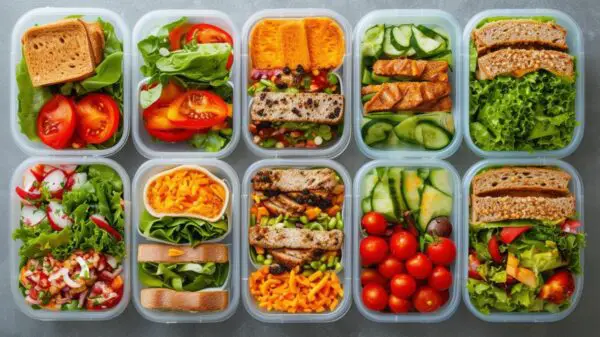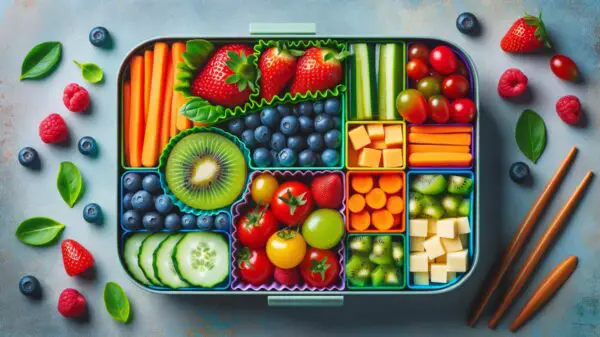As children head back to school, the daily ritual of preparing lunches turns into a significant part of the family’s routine. Providing a healthy and exciting lunchbox is often a challenge that requires forethought and organization. Imagine crafting a week’s worth of meals that not only appeal to your child’s taste buds but also cater to their growing bodies’ nutritional needs. With an emphasis on variety and balance, the art of meal prepping for school lunches is about more than just filling a box; it’s about nourishing young minds and bodies. In the following sections, we’ll journey through the process of planning well-balanced menus, navigating the grocery aisles efficiently, and ensuring food safety and storage, so every lunchbox is a treasure chest of wholesome goodness. Keep reading to transform this daily task into an opportunity to foster health, happiness, and a little bit of kitchen creativity.
Planning Well-Balanced Menus
School Lunch Simplified: Ensuring Your Kids’ Meals Are Perfectly Balanced
Hey there, fellow parents and guardians! Are you dancing the daily lunch prep jig, wondering how to pack a school lunch that’s both nutritious and kid-approved? You’re not alone! A balanced diet is the cornerstone of our children’s health and success at school, and it’s up to us to make that brown bag lunch not just boring but a powerhouse of nutrients. Let’s dive into some tips and tricks that guarantee your kids will have the energy they need to learn, play, and grow!
Start with a Colorful Foundation
Firstly, let’s talk about fruits and veggies. They’re not just vibrant and fun – they pack a nutritional punch that’s vital for your child’s development. Aim to include a variety of colors in their lunchbox. Think cherry tomatoes, bell pepper strips, carrot sticks, or a small box of berries. These fiber-filled goodies will keep their digestive systems happy and their minds alert.
Protein is Key
Next up, protein – it’s essential for growing bodies. Now, this doesn’t mean you’re limited to the usual deli slices. Get creative with hard-boiled eggs, beans, chickpea salads, or quinoa. These alternatives not only add a twist to the usual suspects but also offer a variety of amino acids that are crucial for growth.
Whole Grains for the Win
Carbs are not the enemy – in fact, they’re the primary energy source for active kids. Swap out white bread for whole grains like oat bread, whole-wheat wraps, or mixed-grain rice. These will ensure a steady release of energy throughout the day, keeping those mid-day slumps at bay.
Don’t Forget Healthy Fats
Healthy fats are often overlooked in a child’s diet. Adding some avocado slices, a spoonful of natural peanut butter, or a sprinkle of seeds can improve brain health and keep your child’s skin glowing. Remember, a little goes a long way!
Dairy or Dairy Alternatives for Strong Bones
A source of calcium is important for strong bones and teeth. If dairy sits well with your little ones, great! Include a string cheese or a yogurt cup. If not, there are plenty of alternatives like calcium-fortified almond milk or soy yogurt that will do the trick.
Hydration is Crucial
Lastl, don’t forget to send them off with a water bottle. Keeping hydrated is as important as the food they eat. Encourage them to refill their bottle at school to ensure they stay hydrated.
Mix It Up
Variety is the spice of life, and this is especially true when it comes to school lunches. Don’t get stuck in a rut. Keep things interesting by introducing new fruits and veggies, playing around with different protein sources, and using an assortment of whole-grain options. This will not only keep your kids from growing weary of their lunch but will also introduce them to a broader range of nutrients.
By following these simple guidelines, you’ll be packing a school lunch that ticks all the nutritional boxes! And who knows, those lunchtime swaps and colorful containers just might spark some new food favorites for your kiddos. Here’s to happy, healthy eating – one lunchbox at a time.

Efficient Grocery Shopping
Ah, grocery shopping for meal prep—it can be quite the expedition, can’t it? Venturing through those bustling aisles, hunting for bargains, and planning out a week’s worth of nutrition for the family—it’s practically an art form! Here are some strategies to take the chaos out of your grocery runs and turn them into streamlined excursions of efficiency and health.
First things first, make friends with meal planning. Before even thinking about stepping foot in the store, sit down with a cup of your favorite brew, and hammer out a weekly meal plan. This isn’t just deciding on dinners. Oh no, this includes breakfasts, lunches, snacks, everything. Think about how leftovers can reinvent themselves as lunch the next day. Double-duty dishes are your secret weapon.
Next, it’s time to construct that master list. And by master, we’re talking Iron Chef-level of detail. Section your list by grocery store departments. Produce over here, dairy over there. Consider your grocery’s layout to prevent the back-and-forth dance we’ve all found ourselves doing when we realize we forgot something three aisles back.
Now, on to the store. Did you know the outer perimeter of the grocery store is where most of the fresh food tends to live? Stick to it like glue. This is where you’ll make most of your stops, picking up those vibrant fruits and veggies, lean meats, dairy, and bread. The middle aisles can be traps for less healthy, processed foods, but they’re also the homes of spices, grains, and legumes—your meal prep allies.
But ah! Don’t let discounts derail you. Sure, keep your eagle eyes on those deals, but only if they fit into your meal plan. Random goodies on sale might seem like a win for your wallet, but if they don’t have a spot in your prep, they’re just pantry clutter in the making.
An underrated strategy is becoming one with your freezer. Look, frozen veggies and fruits can be just as nutritious as their fresh counterparts, and they’re great for adding to meals in a pinch without worrying about spoilage. Bulk cooking is also freezer-friendly. Make large portions, divide it into family-sized servings, freeze them, and voila! Several meals, no added stress.
Strategic shopping goes beyond the store. Sustainability counts, friends. It’s always a win to choose eco-friendly packaging or bulk items to minimize waste. Plus, supporting local farmers and producers is a boon for the community—it’s nourishment with a heart.
And lastly, when at the register, remember this isn’t just about food. It’s about nurturing those around the dinner table. Each item on the conveyor belt is a building block for healthy habits at home. With these strategies in tow, meal prep becomes an extension of the loving care we pour into our families.
Now go forth, meal prep warriors, with list in hand and plan in mind. Happy shopping, happy prepping, and here’s to meals that bring more than just sustenance but also joy to those cherished family moments around the table.

Food Safety and Storage
Ensuring that our little scholars’ lunches stay safe from the time they’re lovingly prepared to the moment they’re enjoyed at school is just as crucial as packing all those nutritious goodies.
It starts with cleanliness; make sure hands, surfaces, and all the containers are squeaky clean before even beginning to prepare food. We wouldn’t want any unseen germs joining in on the lunchtime fun! And, don’t forget about the lunchbox itself – a quick wipe-down or going through the washing machine, if it’s fabric, will go a long way.
When it comes to proteins, dairy, or anything perishable, a cold pack is your trusted sidekick, keeping those yogurt cups and turkey sandwiches safe and cool. To amp up the chill factor, freeze water in a bottle the night before and pop it in the lunch bag; it’ll serve double-duty as an ice pack and a refreshing drink as it thaws.
Now, on warmer days when the sun seems to have it out for our packed lunches, consider doubling up on those ice packs. Also, opt for an insulated lunch bag, a superhero against the perils of a hot school bus or playground.
Storing leftovers can be a game of strategy – refrigerate or freeze them within two hours because bacteria don’t play fair. And when crossing into the next day, reheating should hit the safe temperature zone to knock out any possible bacteria that thought they could make a comeback.
Finally, let’s talk about those containers. Sure, cute is a plus, but durable, leak-proof, and BPA-free are the non-negotiable traits for a container that’s going into battle against locker jostles and backpack bumps.
Remember, when our kids head off with their lunch bags, those bags are keeping more than just food — they’re holding a little piece of home. Let’s make sure it’s a safe and scrumptious piece that keeps them powered up for their schoolyard adventures!

The rhythm of slicing, dicing, and compartmentalizing each meal into its colorful container becomes a symphony of good health and satisfaction. As the last sandwich is snugly wrapped and the final piece of fruit is tucked away, a sense of achievement fills the air. You have not only conquered the week’s school lunch prep with skill but have also instilled crucial nutritional habits that will benefit your children for a lifetime. Navigating through well-balanced menus, smart grocery shopping, and meticulous food handling, you have become an adept at orchestrating an essential part of your child’s daily routine. Carry these lessons forward, and watch as every lunch served becomes a testament to your dedication to their well-being. Armed with practical knowledge and a sprinkle of love, the lunchboxes you prepare will surely be the highlight of your child’s school day.




























